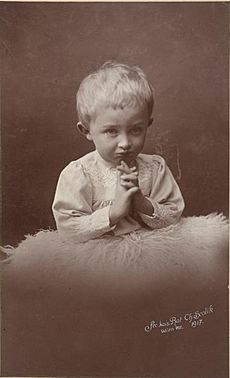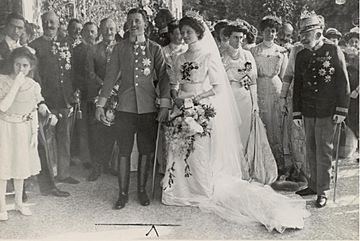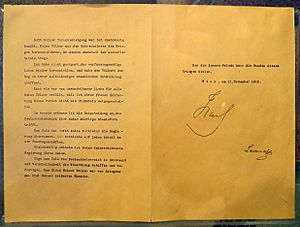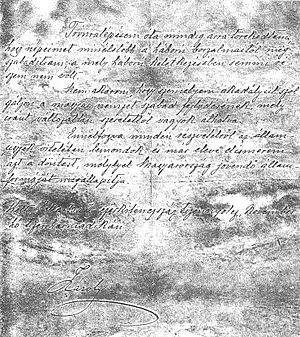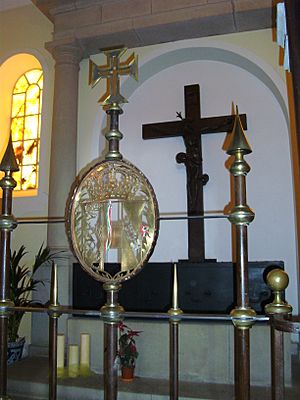Charles I of Austria facts for kids
Quick facts for kids Charles I |
|||||
|---|---|---|---|---|---|

Charles I, c. 1919
|
|||||
| Emperor of Austria King of Hungary (more...) |
|||||
| Reign | 21 November 1916 – 12 November 1918 | ||||
| Coronation | 30 December 1916, Budapest | ||||
| Predecessor | Franz Joseph I | ||||
| Successor | Monarchy abolished | ||||
| Head of the House of Habsburg-Lorraine | |||||
| Reign | 21 November 1916 – 1 April 1922 | ||||
| Successor | Otto von Habsburg | ||||
| Born | 17 August 1887 Persenbeug Castle, Persenbeug-Gottsdorf, Austria-Hungary |
||||
| Died | 1 April 1922 (aged 34) Funchal, Madeira, Portugal |
||||
| Spouse | |||||
| Issue |
|
||||
|
|||||
| House | Habsburg-Lorraine | ||||
| Father | Archduke Otto Franz of Austria | ||||
| Mother | Princess Maria Josepha of Saxony | ||||
| Religion | Roman Catholicism | ||||
| Signature |  |
||||
Charles I (also known as Karl I) was the last Emperor of Austria and King of Hungary. He was born on 17 August 1887, and died on 1 April 1922. He belonged to the House of Habsburg-Lorraine, a very old and powerful royal family.
Charles became the heir to the throne in 1914 after his uncle, Archduke Franz Ferdinand of Austria, was assassinated. This event helped start World War I. In 1911, Charles married Princess Zita of Bourbon-Parma. He is honored in the Catholic Church as Blessed Karl of Austria, having been made "Blessed" by Pope John Paul II in 2004.
Charles became emperor in November 1916, during World War I. He tried to make peace with the other countries fighting in the war, but he was not successful. He also tried to keep his empire together by giving more power to different ethnic groups. However, the empire began to break apart. Countries like Czechoslovakia and Hungary declared their independence.
After the war ended in November 1918, Charles stepped back from governing. He never officially gave up his title as emperor. But the Republic of German-Austria was created, and in 1919, the Habsburg family was officially removed from power and Charles was sent away from Austria. He spent his exile in Switzerland and later on the island of Madeira, where he died.
Contents
Early Life and Education
Charles was born on 17 August 1887, at Persenbeug Castle in Lower Austria. His parents were Archduke Otto Franz of Austria and Princess Maria Josepha of Saxony. At the time, his great-uncle, Franz Joseph I of Austria, was the emperor.
Charles was raised as a very religious Catholic. He moved around a lot in his early years because of his father's army duties. Later, he lived in Vienna. He was taught at home, but he also went to a public high school (a gymnasium) for science classes. After school, he joined the army. From 1906 to 1908, he was an officer in Prague. While there, he also studied Law and Political Science.
Charles was not very close to his great-uncle, the Emperor. He also didn't get along well with his uncle, Franz Ferdinand. Because of this, Charles didn't know much about government affairs before 1914. He lived a normal life for a prince who wasn't expected to become emperor.
Marriage and Family
In 1911, Charles married Princess Zita of Bourbon-Parma. They had known each other since they were children. They met again in 1909 when Charles was stationed with his army regiment.
Charles's uncle, Franz Ferdinand, had married someone who was not royal enough. This meant his children could not inherit the throne. So, the Emperor wanted Charles to marry someone with a perfect royal background. Zita was a devout Catholic and came from a very respected royal family.
Zita later remembered that Charles seemed to decide quickly that he wanted to marry her. He worried she might get engaged to someone else. Charles traveled to Italy to ask for her hand in marriage. Their engagement was announced on 13 June 1911.
Charles and Zita were married on 21 October 1911, in Austria. Emperor Franz Joseph, who was 81, attended the wedding. He was happy to see the second-in-line to the throne make a good marriage. Charles and Zita had eight children together. Their first son, Otto von Habsburg, was born in 1912.
Becoming Heir and Military Service
Charles's father died in 1906. This meant Charles became the heir to the throne after his uncle, Archduke Franz Ferdinand, was assassinated in Sarajevo in 1914. This assassination was a major event that led to World War I.
Only after this did the old Emperor Franz Joseph start teaching Charles about how to run the country. But the war began, and this political training was interrupted. Charles spent the early part of the war at military headquarters. He did not have much military power at first.
Later, Charles became a Field Marshal in the Austro-Hungarian Army. In 1916, he was given command of a special army group. He was well-liked by his soldiers. He then went to the eastern front to command troops fighting against Russia and Romania.
Charles as Emperor
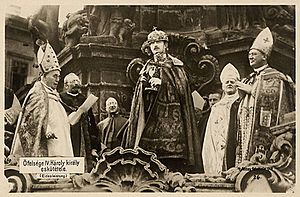
Charles became emperor on 21 November 1916, after his great-uncle Franz Joseph died. He also became the Supreme Commander of the army. On 30 December, he was crowned King of Hungary.
In 1917, Charles secretly tried to make peace with France. He used his brother-in-law, Prince Sixtus, to help. But the Allies (the countries fighting against Austria-Hungary) wanted Austria to give up some land, which Charles refused. So, the peace talks failed. When news of these secret talks leaked, Charles denied them at first. But when letters he signed were published, his foreign minister resigned. This forced Austria-Hungary to give Germany more control over its military.
In the last years of the war, the Austro-Hungarian Empire faced many problems. Different ethnic groups within the empire wanted their own independent nations. U.S. President Woodrow Wilson suggested that the empire should allow its people to govern themselves. Charles agreed to this idea. He wanted to create a system where different national groups could rule themselves within the empire.
However, it was too late. The ethnic groups wanted full independence. For example, a Czechoslovak provisional government was formed, and a South Slav national council declared an independent state.
Efforts for Croatia
Charles wanted to create a third political area in the empire for Croatia, alongside Austria and Hungary. He supported ideas from the Croatian Parliament to give Croatia more power. However, the Hungarian Parliament always said no. They did not want to share power.
In October 1918, Charles agreed to a plan that would create a Croatian kingdom. But this was too late. On 29 October 1918, the Croatian Parliament ended all ties with Hungary and Austria. They declared that all Croatian lands would unite and join the State of Slovenes, Croats and Serbs.
The empire was falling apart. Many nationalities declared their independence. On 31 October, Hungary officially separated from Austria. Charles's empire was now only the German-speaking parts of Austria. His prime minister told him that he should temporarily give up his power.
Leaving Power
On 11 November 1918, the day World War I ended, Charles made a statement. He said that the Austrian people had the right to decide how their country would be run. He also said he would "relinquish every participation in the administration of the State." He released his officials from their promise to be loyal to him. The imperial family then left their palace.
Two days later, Charles made a similar statement for Hungary. Many people thought these statements meant he had given up his throne, but Charles never used the word "abdication." He hoped that the people might ask him to return later. He privately said he felt forced to make the statements.
The day after Charles's first statement, the independent Republic of German-Austria was created. Then, the First Hungarian Republic was declared. Charles left Austria for Switzerland in March 1919. As he left, he made another statement, saying that anything the new Austrian government had decided since November 11 was not valid for him.
The Austrian government did not know about this statement at first. They were annoyed that the Emperor had left without officially giving up his throne. So, on 3 April, the Austrian Parliament passed the Habsburg Law. This law removed the Habsburg family from power and banned Charles from ever returning to Austria. Other male Habsburgs could only return if they gave up any claim to the throne and became regular citizens.
Attempts to Regain the Throne
After the Kingdom of Hungary was restored, Charles tried twice in 1921 to get his Hungarian throne back. He was encouraged by Hungarian royalists (people who wanted a king). However, Miklós Horthy, who was the regent (a temporary ruler) of Hungary, refused to support Charles. Horthy believed that if Charles returned, neighboring countries would invade Hungary.
Later in 1921, the Hungarian parliament officially removed the Habsburgs from the Hungarian throne.
Exile and Death
After his second failed attempt to regain the Hungarian throne, Charles and his pregnant wife, Zita, were arrested. They were sent to the Portuguese island of Madeira. This was their final place of exile.
The couple and their children lived in a modest home in Monte, Madeira. Charles never left the island. On 9 March 1922, he caught a cold that turned into severe pneumonia. He died on 1 April 1922, at the age of 34. He was conscious almost until the end. His last words to his wife were "I love you so much."
Charles's body is still on Madeira, in a chapel in the Church of Our Lady of the Mount. His heart and his wife's heart are buried in Muri Abbey, Switzerland.
Legacy
Historians have different opinions about Charles. Some see him as a brave and honorable leader who tried to stop the war. Others believe he was not strong enough for the challenges he faced.
The French writer Anatole France said that Charles was "the only decent man to have appeared in this war." He believed Charles sincerely wanted peace.
Beatification
| Blessed Karl of Austria |
|
|---|---|

Charles I of Austria with the habit of the Order of Saint Stephen of Hungary
|
|
| Emperor and Confessor | |
| Venerated in | Catholic Church |
| Beatified | 3 October 2004, Saint Peter's Square, Vatican City by Pope John Paul II |
| Major shrine | Church of Our Lady of Monte, Funchal, Portugal |
| Feast | 21 October |
| Attributes |
|
| Patronage | World peace |
Leaders in the Catholic Church have praised Charles. They say he always put his Christian faith first in his decisions. They also honor him for trying to bring peace during World War I.
The process to make him a saint began in 1949. In 1954, he was declared a "servant of God," which is the first step. In 1972, when his tomb was opened, his body was found to be well-preserved.
In 2003, the Vatican declared Charles had "heroic virtues." This gave him the title "venerable." Later that year, the Church confirmed a miracle happened through Charles's prayers. A Brazilian nun with serious varicose veins was healed after she prayed for his beatification.
Pope John Paul II declared Charles "Blessed" on 3 October 2004. The Pope also set 21 October as Charles's feast day, which is the date he married Princess Zita. At the ceremony, the Pope said that Charles always tried to follow God's will. He called war "something appalling" and tried to promote peace.
Charles believed his role as emperor was a holy service to his people. He cared deeply about helping others. In 2008, a second miracle was recognized. A person in Florida was reportedly cured after people prayed for Charles's help.
Children
Charles and Princess Zita of Bourbon-Parma had eight children together.

| Name | Birth | Death | Notes |
|---|---|---|---|
| Crown Prince Otto | 20 November 1912 | 4 July 2011 (aged 98) | married (1951) Princess Regina of Saxe-Meiningen (1925–2010); seven children. |
| Archduchess Adelheid | 3 January 1914 | 2 October 1971 (aged 57) | |
| Archduke Robert | 8 February 1915 | 7 February 1996 (aged 80) | married (1953) Princess Margherita of Savoy-Aosta (7 April 1930 – 10 January 2022); five children. |
| Archduke Felix | 31 May 1916 | 6 September 2011 (aged 95) | married (1952) Princess Anna-Eugénie of Arenberg (5 July 1925 – 9 June 1997); seven children. |
| Archduke Karl Ludwig | 10 March 1918 | 11 December 2007 (aged 89) | married (1950) Princess Yolanda of Ligne (born 6 May 1923); four children. |
| Archduke Rudolf | 5 September 1919 | 15 May 2010 (aged 90) | married (1953) Countess Xenia Czernichev-Besobrasov (11 June 1929 – 20 September 1968); four children. Second marriage (1971) Princess Anna Gabriele of Wrede (born 11 September 1940); one child. |
| Archduchess Charlotte | 1 March 1921 | 23 July 1989 (aged 68) | married (1956) George, Duke of Mecklenburg (5 October [O.S. 22 September] 1899 – 6 July 1963). |
| Archduchess Elisabeth | 31 May 1922 | 7 January 1993 (aged 70) | married (1949) Prince Heinrich Karl Vincenz of Liechtenstein (5 August 1916 – 17 April 1991), grandson of Prince Alfred; five children. |
Images for kids
See also
 In Spanish: Carlos I de Austria y IV de Hungría para niños
In Spanish: Carlos I de Austria y IV de Hungría para niños
- List of heirs to the Austrian throne


